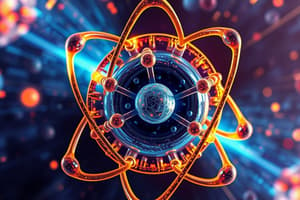Podcast
Questions and Answers
What is the primary function of the conductive tip in Scanning Tunneling Microscopy (STM)?
What is the primary function of the conductive tip in Scanning Tunneling Microscopy (STM)?
The conductive tip scans the surface to measure the tunneling current, providing information about the surface at the atomic level.
Explain the difference between Constant Current Mode and Constant Height Mode in STM.
Explain the difference between Constant Current Mode and Constant Height Mode in STM.
In Constant Current Mode, the tip's height is adjusted to maintain a constant tunneling current, while in Constant Height Mode, the tip remains at a fixed distance, yielding faster imaging but less stability.
What information can be extracted from Scanning Tunneling Spectroscopy (STS) measurements?
What information can be extracted from Scanning Tunneling Spectroscopy (STS) measurements?
STS measurements provide insights into the electronic properties of materials by analyzing the tunneling current as a function of voltage, revealing the local density of states.
Identify one major limitation of STM and explain its potential impact on data interpretation.
Identify one major limitation of STM and explain its potential impact on data interpretation.
How has the development of sharper tips influenced the resolution of STM imaging?
How has the development of sharper tips influenced the resolution of STM imaging?
What advantage does cryogenic STM offer in the study of material properties?
What advantage does cryogenic STM offer in the study of material properties?
What is the purpose of functionalized tips in STM, and how do they improve imaging?
What is the purpose of functionalized tips in STM, and how do they improve imaging?
Describe how time-resolved STM contributes to our understanding of ultrafast phenomena.
Describe how time-resolved STM contributes to our understanding of ultrafast phenomena.
Flashcards are hidden until you start studying
Study Notes
Techniques
-
Scanning Tunneling Microscopy (STM):
- A high-resolution imaging technique used to study surfaces at the atomic level.
- Utilizes a conductive tip that scans across a surface to measure tunneling current.
-
Constant Current Mode:
- Maintains a constant tunneling current by adjusting the tip's height.
- Provides detailed topographical information.
-
Constant Height Mode:
- The tip stays at a fixed distance from the surface; variations in current provide information.
- Faster imaging but less stable and can cause tip-sample interaction.
-
Spectroscopy Techniques:
- STS (Scanning Tunneling Spectroscopy): Measures the tunneling current as a function of voltage to study electronic properties.
- Allows for the investigation of local density of states.
-
Simulation Support:
- Computational methods can assist in predicting STM results, providing context for experimental data.
Data Interpretation
-
Topographic Imaging:
- STM produces 2D images that represent surface features, showing height variations.
- The resolution can reach atomic dimensions.
-
Tunneling Current Analysis:
- Current intensity indicates surface electronic structures.
- Higher current often correlates with higher local density of states.
-
Spectroscopy Results:
- STS curves provide insight into electronic band structures and energy levels.
- Interpretation involves understanding peaks and troughs related to electronic states.
-
Artifacts & Limitations:
- Factors such as tip geometry, sample cleanliness, and environmental conditions can introduce errors.
- It's critical to distinguish true surface features from noise or artifacts.
Advancements In STM Technology
-
Increased Resolution:
- Development of sharper tips and advanced control systems has improved imaging at atomic resolutions.
-
Cryogenic STM:
- Combines STM with cryogenic temperatures to observe materials' properties at low temperatures, yielding insights into superconductivity and other phenomena.
-
Time-resolved STM:
- Enables observation of dynamic processes on surfaces in real-time, leading to a better understanding of ultrafast phenomena.
-
Functionalized Tips:
- Enhanced tips with specific chemical groups allow for improved contrast in imaging and selective interaction with surface molecules.
-
Integration with Other Techniques:
- Coupling STM with techniques like Atomic Force Microscopy (AFM) or X-ray Photoelectron Spectroscopy (XPS) provides multi-faceted analyses of materials.
Scanning Tunneling Microscopy (STM)
- A powerful imaging technique providing atomic-scale surface details.
- Utilizes a sharp conductive tip to scan a surface and measure tunneling current.
- Constant Current Mode: Provides detailed topography by adjusting tip height to maintain constant current.
- Constant Height Mode: Offers faster imaging but is less stable and can cause tip-sample interactions.
- STS (Scanning Tunneling Spectroscopy): Measures tunneling current changes with voltage, revealing electronic properties and local density of states.
Data Interpretation
- Topographic Imaging: Produces 2D images representing surface features, showing height variations with atomic-scale resolution.
- Tunneling Current Analysis: Intensity reflects surface electronic structure, with higher current often indicating higher local density of states.
- Spectroscopy Results: STS curves reveal electronic band structures and energy levels, with peaks and troughs representing specific electronic states.
- Artifacts & Limitations: Tip geometry, sample cleanliness, and environmental conditions can introduce errors, requiring careful interpretation.
Advancements In STM Technology
- Increased Resolution: Sharper tips and advanced control systems achieve atomic-scale imaging.
- Cryogenic STM: Combines STM with low temperatures to study materials at cryogenic temperatures, providing insights into superconductivity and other low-temperature phenomena.
- Time-resolved STM: Enables real-time observation of dynamic processes on surfaces, offering insights into ultrafast phenomena.
- Functionalized Tips: Specialized tips with specific chemical groups enhance contrast and selective interaction with surface molecules.
- Integration with Other Techniques: Combining STM with AFM or XPS provides comprehensive multi-faceted analysis of materials.
Studying That Suits You
Use AI to generate personalized quizzes and flashcards to suit your learning preferences.




